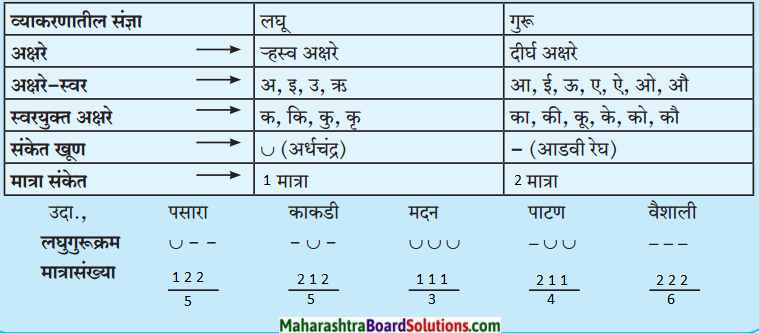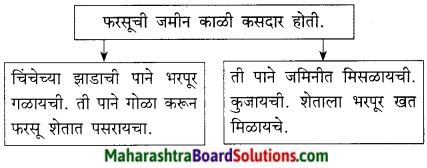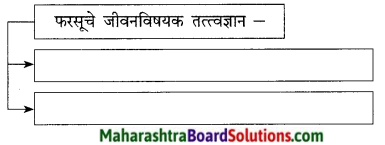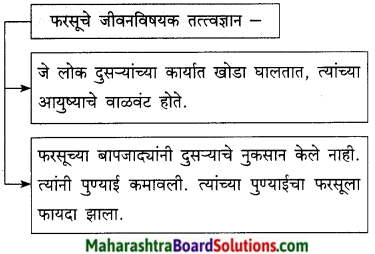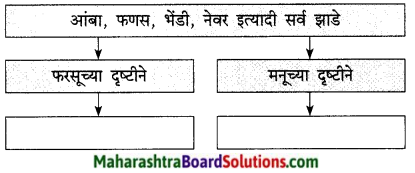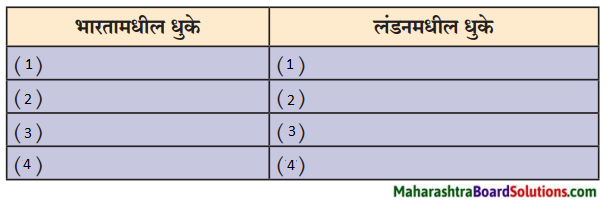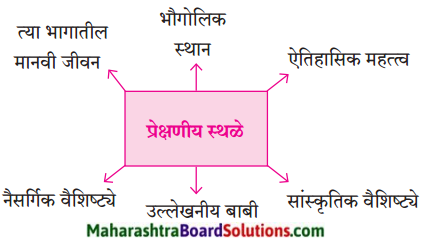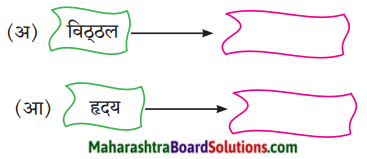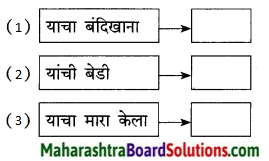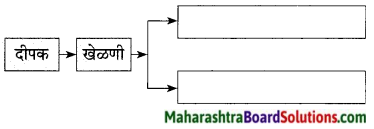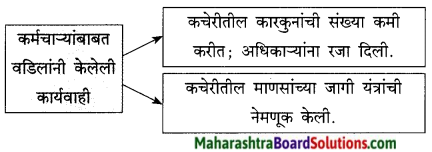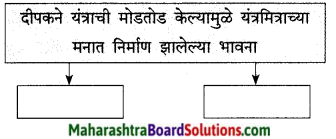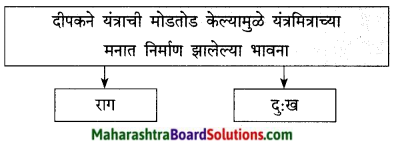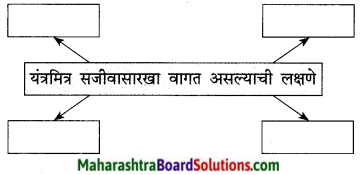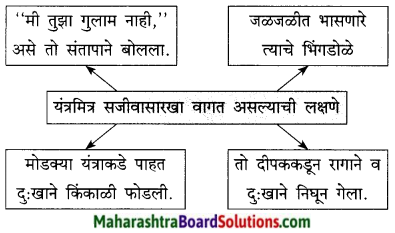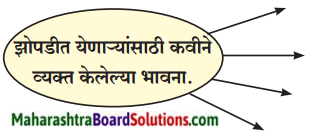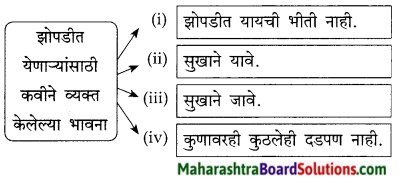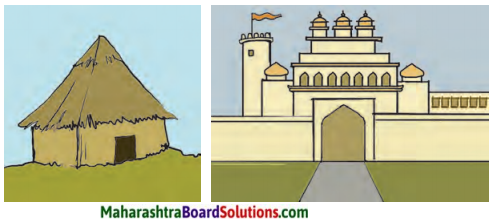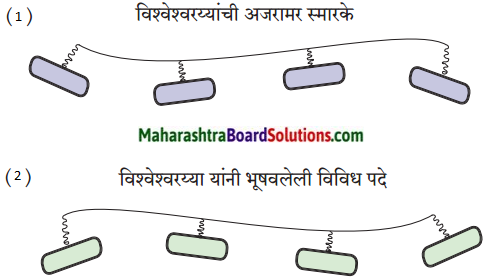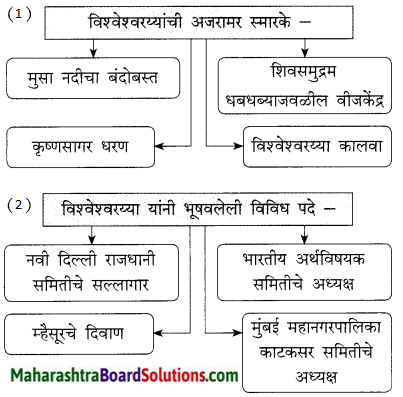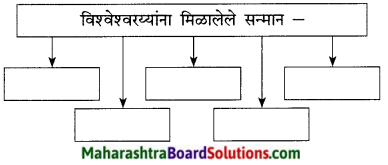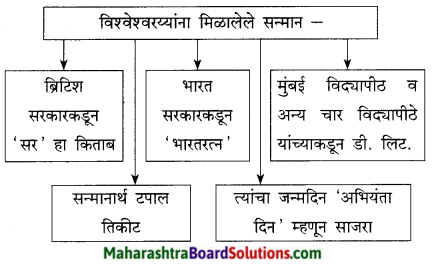Balbharti Maharashtra State Board Class 9 Marathi Solutions Aksharbharati Chapter 14 ते जीवनदायी झाड Notes, Textbook Exercise Important Questions and Answers.
Class 9 Marathi Aksharbharati Chapter 14 ते जीवनदायी झाड Question Answer Maharashtra Board
ते जीवनदायी झाड Std 9 Marathi Chapter 14 Questions and Answers
1. कारणे लिहा.
प्रश्न 1.
लेखकाला लिंबाचे झाड जीवनदायी वाटले, कारण …..………
उत्तरः
लेखकाला लिंबाचे झाड जीवनदायी वाटले, कारण आजूबाजूचा सगळा प्रदेश उन्हाचा असला तरी लिंबाचे ते झाड लसलशीत हिरवेगार आणि चैतन्यमय होते.

प्रश्न 2.
पारव्याची जोडी लिंबाच्या झाडावर राहते, कारण …..…………….
उत्तरः
भोवतालच्या रखरखीत वातावरणात ते लिंबाचं झाड एक थंड असा आश्रय होता.
प्रश्न 3.
लेखकाला खिडकी लावून घ्यावी असे वाटले, कारण …..………….
उत्तर:
लिंबाच्या एका छोट्या फांदीवर मधमाश्यांचं पोळंही रचलं जाऊ लागलं.
2. चौकट पूर्ण करा.
प्रश्न 1.
चौकट पूर्ण करा.

उत्तर:

3. लिंबाच्या झाडाला खालील वैशिष्ट्ये कोणी कोणी प्राप्त करून दिली.
प्रश्न 1.
संगीतमय झाड
उत्तरः
चिमण्या आणि इतर पक्षी
प्रश्न 2.
आश्रयदायी झाड
उत्तर:
गोगलगाई, पारवा, चिमण्या, बुलबुल, पोपट, मुंग्या, किटक, किडे, साप, कुत्री, खार, फुलपाखरे, भुंगे, मधमाशी, माणसे इ.

प्रश्न 3.
आश्वासक झाड
उत्तरः
तुरेदार बुलबुल आणि पोपट
प्रश्न 4.
जीवनदायी झाड
उत्तरः
सर्व सजीव
4. परसदार या शब्दापासून चार अर्थपूर्ण शब्द तयार करा.
प्रश्न 1.
परसदार या शब्दापासून चार अर्थपूर्ण शब्द तयार करा.
उत्तरः
दार, सरदार, रस, दास, पर, सर, सदा
5. पाठात वर्णन आलेल्या दोन कुटुंबाची दिलेल्या मुददयांच्या आधारे तुलना करा.
प्रश्न 1.
पाठात वर्णन आलेल्या दोन कुटुंबाची दिलेल्या मुददयांच्या आधारे तुलना करा.
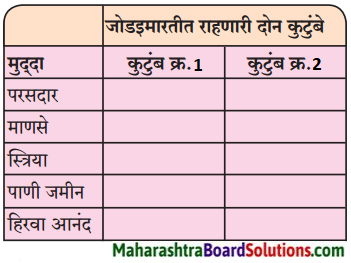
उत्तरः
| मुददा |
कुटुंब क्र 1 |
कुटुंब क्र 2 |
| परसदार |
परसदारात हिरवेगार लिंबाचे झाड होते. |
परसदारात गवताची काडीही नव्हती. |
| माणसे |
ताजेतवाने, निर्मितीक्षम. |
उदास, दुर्मुखलेली त्रस्त. |
| पाणी, जमीन |
कमी प्रमाणात उपलब्ध पण योग्य वापर. |
मुबलक होते पण उपयोग केला नाही. |
| स्त्रिया |
आनंदी, हळव्या. |
नेहमी दागिने घालून बसत. |
| हिरवा आनंद |
हिरवा आनंद पसरवण्यातकडूपणाच्या, कंजुषीच्या मर्यादा घातल्या नाहीत. |
हिरवा आनंद पसरवण्याचा प्रयत्न कधी केला नाही. |

7. चूक की बरोबर ते लिहा.
प्रश्न 1.
चूक की बरोबर ते लिहा.
- परसदारी पाण्याचा हापसा असलेल्या शेजाऱ्यांची बाग फुललेली होती.
- इतर पक्ष्यांच्या त्रासामुळे पारव्याची जोडी लिंबाच्या झाडावरून हलली.
- लिंबाचं झाड लावणारी स्त्री अत्यंत हळवी होती.
- लिंबाच्या झाडावर मधमाश्या कधी कुणाला चावल्या नाहीत.
उत्तर:
- चूक
- चूक
- बरोबर
- बरोबर
8. स्वमत
प्रश्न 1.
1. वृक्ष व मानवी जीवन यांच्यातील परस्परसंबंधांविषयी तुमचे मत सोदाहरण स्पष्ट करा. (उतारा 2 मधील कृती 4: स्वमतचे उत्तर पहा.)
2. झाड सजीवांसाठी जीवनदायी केंद्र कसे बनू शकते, हे विधान पटवून द्या. (उतारा 4 मधील कृती 4: स्वमतचे उत्तर पहा.)

9. अभिव्यक्ती.
प्रश्न 1.
लेखकाच्या मुलाने पारव्यांच्या जोडीचा आश्रय – त्यांचे घरटे वारंवार पाहिल्यामुळे पारव्याचे जोडपे हळूहळू दिसेनासे झाले. ही घटना तुम्हाला काय सांगते, ते स्पष्ट करा.
Marathi Akshar Bharati Class 9 Textbook Solutions Chapter 14 ते जीवनदायी झाड Additional Important Questions and Answers
पुढील उताऱ्याच्या आधारे दिलेल्या सूचनेनुसार कृती करा:
कृती 1 : आकलन कृती
प्रश्न 1.
आकृतिबंध पूर्ण करा.
उत्तर:

प्रश्न 2.
उत्तर लिहा.
आसमंत तापून जाण्याचे कारण ……………..
उत्तरः
त्या भागात उन्हाळा जास्त होता.

प्रश्न 3.
जोड्या जुळवा.
| अ गट |
ब गट |
| 1. लसलशीत हिरवंगार |
(अ) उन्हाचा |
| 2. शुष्क कोरडी |
(ब) लिंबाचं झाड |
| 3. कुठंच नव्हती |
(क) जमीन |
| 4. सगळा प्रदेश |
(ड) पाणथळ जमीन |
उत्तर:
| अ गट |
ब गट |
| 1. लसलशीत हिरवंगार |
(ब) लिंबाचं झाड |
| 2. शुष्क कोरडी |
(क) जमीन |
| 3. कुठंच नव्हती |
(ड) पाणथळ जमीन |
| 4. सगळा प्रदेश |
(अ) उन्हाचा/ |
खालील प्रश्नांची उत्तरे एका वाक्यात लिहा.
प्रश्न 1.
लेखकाच्या घरामागे कशाचे झाड होते?
उत्तर:
लेखकाच्या घरामागे लिंबाचे झाड होते.
प्रश्न 2.
आसपासची झाडे पाणी नसल्याने कशी झाली होती?
उत्तरः
आसपासची झाडे पाणी नसल्याने मलूल झाली होती.
कंसातील योग्य शब्द वापरून रिकाम्या जागा भरा.
प्रश्न 1.
1. प्रदेश सगळा …………. होता. (उन्हाचा, पावसाचा, सावलीचा, वाऱ्याचा)
2. सगळीकडं ………… कोरडी जमीन. (आर्द्र, ओलसर, तांबडी, शुष्क)
उत्तर:
1. उन्हाचा
2. शुष्क

सहसंबंध लिहा.
प्रश्न 1.
1. मलूल आणि काळपट हिरवी : झाडे ::
शुष्क कोरडी : …………………..
2. आर्द्र : शुष्क :: ओली : ……………..
उत्तर:
1. जमीन
2. कोरडी
कृती 2: आकलन कृती
प्रश्न 1.
योग्य पर्याय निवडून विधान पूर्ण करा.
आसपासची जमीन तापून करपून तपकिरी पडलेली दिसे; कारण ………………
(अ) प्रदेश सगळा सावलीचा होता.
(ब) प्रदेश सगळा उन्हाचा होता.
(क) प्रदेश सगळा चैतन्यमय होता.
(ड) प्रदेश सगळा शुष्क होता.
उत्तरः
आसपासची जमीन तापून करपून तपकिरी पडलेली दिसे; कारण प्रदेश सगळा उन्हाचा होता.
प्रश्न 2.
काय ते लिहा.
लेखकाच्या घरामागचे झाड
उत्तर:
लिंबाचे
प्रश्न 3.
आकृतिबंध पूर्ण करा.
उत्तर:
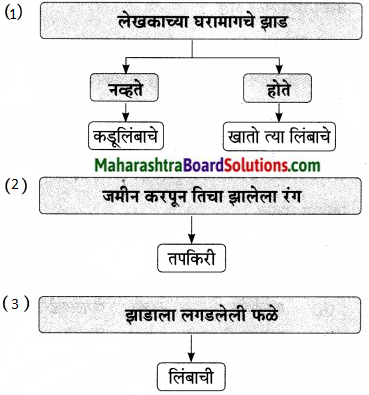

चूक की बरोबर ते लिहा.
प्रश्न 1.
खिडकीलगतच होतं ते काटेरी आणि बोराच्या फळांनी गच्च लगडलेलं असं.
उत्तरः
चूक
प्रश्न 2.
त्या भागात एकूणच उन्हाळा जास्त. आसमंत तापून जाई.
उत्तर:
बरोबर
कृती 3: व्याकरण कृती
प्रश्न 1.
खालील वाक्ये लेखननियमांनुसार शुद्ध करून लिहा.
1. घरसूद्धा तापुन निघे
2. लींब म्हणजे कडुलिंब नव्हे.
उत्तर:
1. घरसुद्धा तापून निघे.
2. लिंब म्हणजे कडूलिंब नव्हे.
प्रश्न 2.
उताऱ्यातील दोन सर्वनामे शोधून लिहा.
उत्तरः
- मी
- त्या
- आपण
- ते
- ती
- या

अचूक शब्द लिहा.
प्रश्न 1.
वीलक्षण, विलक्शन, विलक्षण, विलक्षन
उत्तर:
विलक्षण
प्रश्न 2.
पार्श्वभूमी, पाशभूमी, पाश्वभूमी, पार्श्वभुमी
उत्तरः
पार्श्वभूमी
समानार्थी शब्द लिहा.
प्रश्न 1.
- वृक्ष - [ ]
- प्रांत - [ ]
- सदन - [ ]
- आकाश - [ ]
उत्तर:
- झाड
- प्रदेश
- घर
- आसमंत
अधोरेखित शब्दाचा विरुद्धार्थी शब्द लिहून वाक्य पुन्हा लिहा.
प्रश्न 1.
मी राहत होतो त्या घराच्या मागं एक लिंबाचं झाड होतं.
उत्तरः
मी राहत होतो त्या घराच्या पुढं एक लिंबाचं झाड होतं.

विरुद्धार्थी शब्द लिहा.
प्रश्न 1.
- आर्द्र × [ ]
- पुढं × [ ]
- उदास × [ ]
- मृत्युमय × [ ]
उत्तर:
- शुष्क
- मागं
- चैतन्यमय
- जीवनमय
प्रश्न 7.
अधोरेखित शब्दाची जात ओळखा.
ते झाड म्हणजे विलक्षण जीवनमय आणि जीवनदायी वाटे.
उत्तर:
उभयान्वयी अव्यय
पुढील विशेषणे कशासाठी वापरण्यात आली ते लिहा.
प्रश्न 1.
लसलशीत हिरवंगार
उत्तरः
लिंबाचं झाड

प्रश्न 2.
शुष्क कोरडी
उत्तर:
जमीन
प्रश्न 3.
तक्ता पूर्ण करा.
उत्तर:
| शब्द |
प्रत्यय |
विभक्ती |
| घराच्या |
च्या |
षष्ठी (एकवचन) |
| फळांनी |
नी |
तृतीया (अनेकवचन) |
| परिसरात |
त |
सप्तमी (एकवचन) |
प्रश्न 4.
तक्ता पूर्ण करा.
उत्तर:
| शब्द |
मूळ शब्द |
सामान्यरूप |
| घराच्या |
घर |
घरा |
| फळांनी |
फळ |
फळां |
| उन्हाचा |
ऊन |
उन्हा |
| लिंबाच्या |
लिंब |
लिंबा |
प्रश्न 5.
वाक्यातील काळ ओळखा.
मी राहत होतो त्या घराच्या मागं एक लिंबाचं झाड होतं.
उत्तर:
भूतकाळ
प्रश्न 6.
पर्यायी शब्द लिहा.
उत्तर:

कृती 4: स्वमत
प्रश्न 1.
झाडे जीवनदायी असतात या विधानावर तुमचे मत व्यक्त करा.
उत्तरः
झाड म्हटले म्हणजे हिरवळ आलीच. हिरवा रंग हा समृद्धीचा व संपन्नतेने नटलेला असतो. झाडे स्वत:च जीवनमय असतात, ती जीवनदायी असतात. स्वत:च्या जीवनातून ती इतरांचे जीवन फुलवित असतात. इतरांना जीवन जगण्याची प्रेरणा देत असतात. स्वत:च्या दातृत्वातून ती इतरांना जणू जीवनच दान करीत असतात. झाडे सजीवांना प्राणवायू देतात. फळे व फुले अर्पण करत असतात. एक उत्साह, उमंग व प्रसन्नता माणसाच्या मनात निर्माण करतात. त्यांच्याकडे पाहिले की, माणसांचे मन प्रसन्न व टवटवीत होते. अशाप्रकारे झाडे जीवनदायी असतात.

पुढील उताऱ्याच्या आधारे दिलेल्या सूचनेनुसार कृती करा:
कृती 1: आकलन कृती
प्रश्न 1.
आकृतिबंध पूर्ण करा.
उत्तरः

योग्य पर्याय निवडून विधाने पूर्ण करा.
प्रश्न 1.
जमिनीत नेमकी तिथंच ओल असे; कारण …………………..
(अ) पावसाचं पाणी सगळं त्या झाडाला जाई.
(ब) गच्चीवरचं पाणी सगळं त्या झाडाला जाई.
(क) मोरीचं पाणी सगळं त्या झाडाला जाई.
(ड) अंगणातलं पाणी सगळं त्या झाडाला जाई.
उत्तरः
जमिनीत नेमकी तिथंच ओल असे; कारण मोरीचं पाणी सगळं त्या झाडाला जाई.
प्रश्न 2.
आज इथं दिसलेला शंख उदया तिथं दिसे; कारण ……………..
(अ) रात्रीतून तो बराच सरकलेला असे.
(ब) तो पाठीवर शंख घेत असे.
(क) तो रात्रीचाच चालत असे.
(ड) त्याला उचलून दुसरीकडे ठेवले जाई.
उत्तरः
आज इथं दिसलेला शंख उदया तिथं दिस; कारण रात्रीतून तो बराच सरकलेला असे.

उत्तरे लिहा.
प्रश्न 1.
1. लेखकाचा आणि लहान मुलांचा हा कौतुकाचा कार्यक्रम होऊन बसला ……………
2. झाडाखाली असणारी वस्ती …..…………….
उत्तर:
1. गोगलगाईंचा प्रवास निरखणं
2. गोगलगाईंची
जोड्या जुळवा.
प्रश्न 1.
जोड्या जुळवा.
| ’अ’ गट |
‘ब’ गट |
| 1. भिंतीच्या उंचीचे |
(अ) सावली |
| 2. काळीभोर |
(ब) गोगलगाईंची |
| 3. झाडाखाली वस्ती |
(क) लिंबाचे झाड |
उत्तर:
| ’अ’ गट |
‘ब’ गट |
| 1. भिंतीच्या उंचीचे |
(क) लिंबाचे झाड |
| 2. काळीभोर |
(अ) सावली |
| 3. झाडाखाली वस्ती |
(ब) गोगलगाईंची |
उताऱ्यानुसार घटनांचा क्रम लावा.
प्रश्न 1.
- लहान-मोठे अनेक शंख मग दिसून येऊ लागले.
- मोरीचं पाणी सगळं त्या झाडाला जाई.
- त्या ओलसर जमिनीत मला काही शंख दिसू लागले.
- त्यामुळे जमिनीत नेमकी तिथंच ओल असे.
उत्तर:
- मोरीचं पाणी सगळं त्या झाडाला जाई.
- त्यामुळे जमिनीत नेमकी तिथंच ओल असे.
- त्या ओलसर जमिनीत मला काही शंख दिसू लागले.
- लहान-मोठे अनेक शंख मग दिसून येऊ लागले.

खालील प्रश्नांची उत्तरे एका वाक्यात लिहा.
प्रश्न 1.
फांदीवरील गोगलगाई कोणत्या रंगानं बरबटलेल्या असत?
उत्तरः
फांदीवरील गोगलगाई चिकट रंगानं बरबटलेल्या असत.
प्रश्न 2.
लिंबाचं झाड कोणाच्या दिलाशाचं केंद्र झालं होतं?
उत्तर:
लिंबाचं झाड सजीवांच्या दिलाशाचं केंद्र झालं होतं.
प्रश्न 3.
लिंबाखालच्या ओलसर जमिनीत लेखकाला कोणता सजीव दिसला?
उत्तरः
लिंबाखालच्या ओलसर जमिनीत लेखकाला शंख हा सजीव दिसला.
कंसातील योग्य शब्द वापरून रिकाम्या जागा भरा.
प्रश्न 1.
1. गोगलगाई शंख ……………… घेऊन चालतात. (मानेवर, खांदयावर, पायांवर, पाठीवर)
2. त्या झाडाखाली ………….. सावली असे. (काळीकुट्ट, काळीमिट्ट, काळीभोर, काळीकुळकुळीत)
उत्तर:
1. पाठीवर
2. काळीभोर
सहसंबंध लिहा.
प्रश्न 1.
दिलाशाचं : केंद्र :: काळीभोर : ………..
उत्तर:
सावली.

कृती 2: आकलन कृती
प्रश्न 1.
कोण ते लिहा.
गोगलगाईंचा प्रवास पाहणारे.
उत्तर:
लेखक आणि लहान मुले.
प्रश्न 2.
आकृतिबंध पूर्ण करा.
उत्तर:
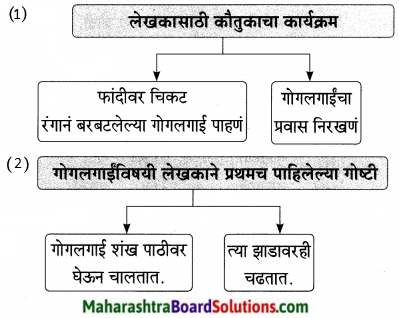

प्रश्न 3.
चूक की बरोबर ते लिहा.
1. त्यामुळे जमिनीत नेमकी तिथंच ओल असे.
2. आज इथं दिसलेला शंख उदया दिसेनासा होई.
उत्तर:
1. बरोबर
2. चूक

कृती 3: व्याकरण कृती
खालील वाक्ये लेखननियमांनुसार शुद्ध करून लिहा.
प्रश्न 1.
रात्रितून तो बराच सकरलेला असे.
उत्तरः
रात्रीतून तो बराच सरकलेला असे.
प्रश्न 2.
त्यामुळं जमीनीत नेमकि तिथंच ओल असे.
उत्तरः
त्यामुळे जमिनीत नेमकी तिथंच ओल असे.
उताऱ्यातील दोन सर्वनामे शोधून लिहा.
प्रश्न 1.
उताऱ्यातील दोन सर्वनामे शोधून लिहा.
उत्तरः
- माझ्या
- त्या
- मला
- तो
- मी
- त्यांचा
अचूक शब्द लिहा.
प्रश्न 1.
1. दिलशाचं, दीलशाचं, दिलाशाचं, दिलाशचं (ii) कोतुकाचा,
2. कौतुकाचा, कौतूकाचा, कौतुकचा
उत्तर:
1. दिलाशाचं
2. कौतुकाचा

समानार्थी शब्द लिहा.
प्रश्न 1.
- जल - [ ]
- निशा - [ ]
- वसाहत - [ ]
- छाया - [ ]
उत्तर:
- पाणी
- रात्र
- वस्ती
- सावली
विरुद्धार्थी शब्द लिहा.
प्रश्न 1.
- खोटं × [ ]
- दिवस × [ ]
- निंदा × [ ]
- वर × [ ]
उत्तर:
- खरं
- रात्र
- कौतुक
- खाली
उताऱ्यातील अनेकवचनी शब्द शोधून लिहा.
प्रश्न 1.
उताऱ्यातील अनेकवचनी शब्द शोधून लिहा.
उत्तरः
शंख

प्रश्न 2.
तक्ता पूर्ण करा.
उत्तरः
| शब्द |
प्रत्यय |
विभक्ती |
| जमिनीत |
त |
सप्तमी (एकवचन) |
| भिंतीच्या |
च्या |
षष्ठी (एकवचन) |
| रात्रीतून |
ऊन |
पंचमी (एकवचन) |
| झाडाला |
ला |
द्वितीया (एकवचन) |
प्रश्न 3.
तक्ता पूर्ण करा.
उत्तरः
| शब्द |
मूळशब्द |
सामान्यरूप |
| सजीवांच्या |
सजीव |
सजीवां |
| गोगलगाईची |
गोगलगाय |
गोगलगाई |
| जमिनीत |
जमीन |
जमिनी |
| मुलांचा |
मुले |
मुला |
प्रश्न 4.
अधोरेखित शब्दांच्या जाती ओळखा.
1. आज इथं दिसलेला शंख उदया तिथं दिसे.
2. त्यांचा प्रवास निरखणं हा माझा आणि लहान मुलांचा कौतुकाचा कार्यक्रम होऊन बसला होता.
उत्तर:
1. नाम
2. सर्वनाम

प्रश्न 5.
वाक्यातील काळ ओळखा.
त्यांचा प्रवास निरखणं हा माझा आणि लहान मुलांचा कौतुकाचा कार्यक्रम होऊन बसला होता.
उत्तरः
भूतकाळ
प्रश्न 6.
सहसंबंध लिहा.
मला : सर्वनाम :: शंख : ………
उत्तरः
नाम
प्रश्न 7.
पर्यायी शब्द लिहा.
उत्तरः

कृती 4: स्वमत
प्रश्न 1.
वृक्ष व मानवी जीवन यांच्यातील परस्परसंबंधाविषयी तुमचे मत सोदाहरण स्पष्ट करा.
उत्तरः
वृक्ष व मानवी जीवन यांचे परस्परसंबंध अतूट आहेत. वृक्षांशिवाय मानवाच्या जीवनाची कल्पनाच करता येणार नाही. त्यांच्याशिवाय माणसाचे आस्तित्त्वच राहणार नाही. वृक्ष मानवास प्राणवायू देतात त्यामुळेच माणसास श्वसनास वायू मिळतो. प्राचीन काळापासून पाहिले तर आपल्या लक्षात येईल की, ऋषीमुनींनी याच वृक्षाच्या खाली बसून तप केलेले आहे. त्यांना दिव्यत्वाचा साक्षात्कार या वृक्षामुळेच झालेला आहे. गौतम बुद्धांना ज्ञान बोधिसत्व वृक्षांच्या खालीच मिळाले आहे. तुकोबांनी आपली अभंगरचना वृक्षाच्या सान्निध्यात बसूनच लिहिलेली आहे. ’वृक्षवल्ली आम्हा सोयरी’ असे ते आनंदाने म्हणतात.

पुढील उताऱ्याच्या आधारे दिलेल्या सूचनेनुसार कृती करा:
कृती 1: आकलन कृती
प्रश्न 1.
आकृतिबंध पूर्ण करा.
उत्तरः

उत्तरे लिहा.
प्रश्न 1.
त्यांच्यामुळे झाड नेहमी गजबजलेलं असे.
उत्तर:
चिमण्या आणि इतर पक्षी
प्रश्न 2.
लिंबाच्या काटेरी झाडात घरटे बांधणारी जोडी.
उत्तरः
पारव्याची

प्रश्न 3.
जोड्या जुळवा.
| ’अ’ गट |
’ब’ गट |
| 1. गुंजांच्या डोळ्यांची |
(अ) झाड |
| 2. तुरेदार |
(ब) पारवी |
| 3. संगीतमय |
(क) पक्षी |
| 4. थव्याथव्याने येणारे |
(ड) बुलबुल |
उत्तर:
| ’अ’ गट |
’ब’ गट |
| 1. गुंजांच्या डोळ्यांची |
(ब) पारवी |
| 2. तुरेदार |
(ड) बुलबुल |
| 3. संगीतमय |
(अ) झाड |
| 4. थव्याथव्याने येणारे |
(क) पक्षी |
प्रश्न 4.
उताऱ्यानुसार घटनांचा क्रम लावा.
- मग ते जोडपं हळूहळू दिसेनासं झालं.
- त्या जोडीनं काड्याकाड्यांचं एक घरटं त्या लिंबाच्या काटेरी झाडात बांधायला सुरुवात केली.
- लेखकाचा मुलगा तिथं वारंवार जाऊन पाही.
- लवकरच एक पारव्याची जोडी त्या गर्द हिरव्या आश्चर्यात दिलासा शोधू लागली.
उत्तर:
- लवकरच एक पारव्याची जोडी त्या गर्द हिरव्या आश्चर्यात दिलासा शोधू लागली.
- त्या जोडीनं काड्याकाड्यांचं एक घरटं त्या लिंबाच्या काटेरी झाडात बांधायला सुरुवात केली.
- लेखकाचा मुलगा तिथं वारंवार जाऊन पाही.
- मग ते जोडपं हळूहळू दिसेनासं झालं.

खालील प्रश्नांची उत्तरे एका वाक्यात लिहा.
प्रश्न 1.
गर्द हिरव्या आश्चर्यात कोण दिलासा शोधू लागली?
उत्तर:
एक पारव्याची जोडी गर्द हिरव्या आश्चर्यात दिलासा शोधू लागली.
प्रश्न 2.
पारव्याचं जोडपं हळूहळू दिसेनासं का झालं?
उत्तर:
लेखकाचा मुलगा वारंवार त्यांना जाऊन पाही म्हणून मग ते जोडपं हळूहळू दिसेनासं झालं.
प्रश्न 3.
लिंबाच्या झाडाजवळ नेहमी कोणते पक्षी दिसत?
उत्तर:
लिंबाच्या झाडाजवळ नेहमी तुरेदार बुलबुल आणि पोपट हे पक्षी दिसत.
कंसातील योग्य शब्द वापरून रिकाम्या जागा भरा.
प्रश्न 1.
1. जणू गातं बहरतं …………. झाड. (लययुक्त, सुरेल, संगीतमय, तालयुक्त)
2. लुकलुकत्या नजरेची …………. दृष्टीस पडे (चिमणी, पारवी, बुलबुल, लांडोर)
उत्तर:
1. संगीतमय
2. पारवी

सहसंबंध लिहा.
प्रश्न 1.
1. लुकलुकती : नजर :: बहरतं : ……………….
2. शेवट : सुरुवात :: थंड : ……………………..
उत्तर:
1. झाड
2. तप्त
प्रश्न 2.
शब्दजाल पूर्ण करा.
उत्तर:
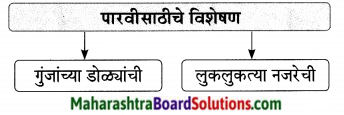
कृती 2: आकलन कृती
प्रश्न 1.
योग्य पर्याय निवडून विधान पूर्ण करा.
ते जोडपं हळूहळू दिसेनासं झालं; कारण …………………
(अ) माझा मुलगा तिथं वारंवार जाऊन पाही.
(ब) झाड हळूहळू सुकत गेलं.
(क) लोक वारंवार तिथं जाऊन पाहत.
(ड) उन्हाळा वाढत गेला.
उत्तर:
ते जोडपं हळूहळू दिसेनासं झालं; कारण माझा मुलगा तिथं वारंवार जाऊन पाही.

प्रश्न 2.
आकृतिबंध पूर्ण करा.
उत्तर:
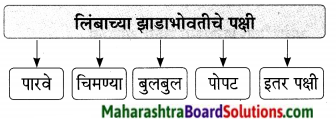
चूक की बरोबर ते लिहा.
प्रश्न 1.
1. तुरेदार पोपट आणि बुलबुल नेहमी तिथं दिसत.
2. मग जोडपं हळूहळू दिसेनासं झालं.
उत्तर:
1. चूक
2. बरोबर
कृती 3 : व्याकरण कृती
प्रश्न 1.
खालील वाक्य लेखननियमांनुसार शुद्ध करून लिहा. चिमन्या आणि इतर पक्षी यांनी ते झाड नेहमि गजबजलेलं असे.
उत्तर:
चिमण्या आणि इतर पक्षी यांनी ते झाड नेहमी गजबजलेलं असे.
प्रश्न 2.
उताऱ्यातील दोन विशेषणे शोधून लिहा.
उत्तर:
- एक
- गर्द
- काटेरी
- गुंजांच्या
- लुकलुकत्या
- संगीतमय
- तुरेदार
- आश्वसनाचं
- विश्वासाचं
- अनेक
- एकमेव

अचूक शब्द लिहा.
प्रश्न 1.
आस्वासन, आश्वाशन, आश्वासन, अश्वासन
उत्तर:
आश्वासन
प्रश्न 2.
लुकलुकत्या, लूकलूकत्या, लुकलुकत्या, लुकलकूत्या
उत्तर:
लुकलुकत्या
समानार्थी शब्द लिहा.
प्रश्न 1.
- दरवाजा - [ ]
- बाट - [ ]
- नयन - [ ]
- नेहमी - [ ]
उत्तर:
- दार
- गर्दै
- डोळे
- वारंवार
विरुद्धार्थी शब्द लिहा.
प्रश्न 1.
- शेवट ×
- गरम ×
- कधीकपी ×
- भरभर ×
उत्तर:
- सुरुवात
- थंड
- नेहमी
- हळूहळू

प्रश्न 6.
उत्ताऱ्यातील दोन अनेकवचनी शब्द शोधून लिहा.
उत्तर:
1. चिमण्या
2. पक्षी
अधोरेखित शब्दांच्या जाती ओळखा.
प्रश्न 7.
लुकलुकत्या नजरेची पारवी दृष्टीस पडे
उत्तर:
विशेषम
प्रश्न 8.
तुरेवर बुलबुल आणि पोपट नेहमी तिथं दिसत.
उत्तर:
उभयान्वयी अव्यय

प्रश्न 9.
तक्ता पूर्ण करा.
उत्तर:
| शब्द |
प्रत्यय |
विभकती |
| वातावरणातून |
ऊन |
पंचमी (एकवचन) |
| पारव्याची |
ची |
पाठी (एकवचन) |
| दृष्टीस |
स |
द्वितीया (एकवचन) |
| पाल्यांना |
ना |
द्वितीया (अनेकवचन) |
प्रश्न 10.
तक्ता पूर्ण करा.
उत्तर:
| शब्द |
मूळ शब्द |
सामान्यरूप |
| खिडकीतून |
खिडकी |
खिडकी |
| डोळ्यांची |
डोळे |
डोळया |
| झाडात |
झाड |
झाडा |
| थव्याथव्यानं |
थवा |
थव्या |
प्रश्न 11.
‘आश्वासन देणे’ या वाक्प्रचाराचा अर्थ लिहून वाक्यात उपयोग करा.
उत्तर:
आश्वासन देणे - हमी देणे
बाक्य: निवडणूक जवळ आल्याने नेतेमंडळी कोरडी आश्वासने देत होती.
प्रश्न 12.
खालील वाक्यात अधोरेखित शब्दांऐवजी पाठात आलेला योग्य वाक्प्रचार शोधून वाक्य पुन्हा लिहा.
गुंजांच्या डोळयांची, लुकलुकत्या नजरेची परवी नजरेस पडे.
उत्तरः
गुंजांच्या डोळांची, लुकलुकत्या नजरेची पारवी दृष्टीस पडे.

प्रश्न 13.
वान्यातील काळ ओळखा.
भोवतालच्या रखरखीतून त्या जोडीनं एक थंड असा आश्रय शोधून काढला होता,
उत्तर:
भूतकाळ
प्रश्न 14.
भविष्यकाळ करा.
तुरेवार बुलबुल अपि पोपट नेहमी विच दिसत.
उत्तरः
तुरेवर बुलबुल अपि पोपट नेहमी तिच दिसतील.
कृती 4 : स्वमत
प्रश्न 1.
झाई जणू पक्ष्यांना जगण्यासाठी नवं आश्वासक निमंत्रण देतात या विधानावर तुमचे स्वमत लिहा.
उत्तरः
झाडे आणि पक्षी यांचे एकमेकांशी अतूट नाते असते. रेशमाचे बंधच जणू त्यांच्यात गुरफटलेले असतात, पक्षी वातावरणात विहार करतात. झाड हेव त्यांचे वित्रामाचे व वास्तव्याचे विकाण असते. सर्व पक्षी झाडांवर बसून किलबिलाट करतात तेक्का असे वाटते की, जणू पक्ष्यांची शाळाच भरलेली आहे. ऊन वारा व पाऊस यांचसून स्वत:चे रक्षण करण्यासाठी पक्षी झाडांवर आपली घरटी बांधतात. झाडाची फळे खातात. झाड हेच त्यांच्या संरक्षणाचे एकमेव साधन असते. जणू झाडेच हिरवीगार होऊन डोलत त्यांना आपल्याकडे बोलावत असतात.

पुढील उताऱ्याच्या आधारे दिलेल्या सूचनेनुसार कृती करा:
कृती 1 : आकलन कृती
प्रश्न 1.
आकृतिबंध पूर्ण करा.
उत्तरः


उत्तरे लिहा.
प्रश्न 1.
लेखकाला झाडाच्या बाबतीत हे पहायला मिळाले नाही.
उत्तर:
फुलांपासून ते फळांपर्यंतचा सगळा जीवनप्रवास
प्रश्न 2.
राहत्या घराच्या मागे लिंबाचे झाड लावणारी.
उत्तरः
दाक्षिणात्य स्त्री

प्रश्न 3.
जोड्या जुळवा.
| ‘अ’ गट |
‘ब’ गट |
| 1. अनेकरंगी |
अ) फुले |
| 2. मंद गोड वासाची |
(ब) पक्षी |
| 3. फुलचुखे चिमुकले |
(क) सजीवांसाठी |
| 4. जीवनदायी केंद्र |
(ड) किडे |
उत्तरः
| ‘अ’ गट |
‘ब’ गट |
| 1. अनेकरंगी |
(ड) किडे |
| 2. मंद गोड वासाची |
(अ) फुले |
| 3. फुलचुखे चिमुकले |
(ब) पक्षी |
| 4. जीवनदायी केंद्र |
(क) सजीवांसाठी |

खालील प्रश्नांची उत्तरे एका वाक्यात लिहा.
प्रश्न 1.
झाडाखाली कोणाचे एक वेगळेच विश्व होते?
उत्तर:
झाडाखाली मुंग्यांचे एक वेगळेच विश्व होते.
प्रश्न 2.
कशामुळे झाडाभोवती पंखधारी चिमुकल्या पऱ्या उडू लागल्या?
उत्तरः
फुलांमुळे झाडाभोवती पंखधारी चिमुकल्या पऱ्या उडू लागल्या.
प्रश्न 3.
लेखकाला केव्हा खिडकी लावून घ्यावी असे वाटू लागले?
उत्तरः
झाडाच्या फांदीवर मधमाश्यांनी छोटे पोळे रचल्यावर लेखकाला खिडकी लावून घ्यावी असे वाटू लागले.

प्रश्न 4.
लिंबाच्या झाडाची कोणती व्याख्या झाली होती?
उत्तर:
‘सजीवांसाठी जीवनदायी केंद्र’ अशी लिंबाच्या झाडाची व्याख्या झाली होती.
प्रश्न 5.
लिंबाचे झाड लावलेल्या स्त्रीनं त्याला कशाच्या मर्यादा घातल्या नव्हत्या?
उत्तर:
लिंबाचे झाड लावलेल्या स्त्रीनं त्याला कडूपणाच्या आणि कंजुषीच्या मर्यादा घातलेल्या नव्हत्या.

कंसातील योग्य शब्द वापरून रिकाम्या जागा भरा.
प्रश्न 1.
1. ……………. लगडलेलं ते झाड दृष्ट लागण्यासारखं होतं. (फुलांनी, फळांनी, फांदयांनी, फुलपाखरांनी)
2. फुलांमुळे लवकरच त्या झाडाभोवती पंखधारी चिमुकल्या ……………….. उडू लागल्या. (चेटकिणी, पऱ्या, चिमण्या, लांडोरी)
3. एकदा पाहत असताना ………….. कात आढळून आली (पालीची, पक्ष्यांची, मगरीची, सापाची)
उत्तर:
1. फळांनी
2. पऱ्या
3. सापाची
प्रश्न 2.
सहसंबंध लिहा.
अनेकरंगी : किडे :: चिमुकल्या : ………
उत्तर:
पऱ्या

प्रश्न 3.
शब्दसमूहासाठी एक शब्द चौकटीत लिहा.
पंख धारण केलेली - [ ]
उत्तर:
पंखधारी
कृती 2: आकलन कृती
प्रश्न 1.
योग्य पर्याय निवडून विधान पूर्ण करा.
आसपासचे लोक येत, लिंबाची फळं मुक्तपणे घेऊन जात, कारण ….………..
(अ) मुक्त-मोकळं झाड तिनं जणू कडूपणाच्या आणि कंजुषीच्या मर्यादा घातलेल्या नव्हत्या.
(ब) मुक्त-मोकळं झाड तिनं जणू सर्व बंधने घातली नव्हती.
(क) मुक्त-मोकळं झाड तिनं जणू कडूपणाच्या आणि कंजुषीच्या मर्यादा घातलेल्या होत्या.
(ड) ती फळेच रसाळ होती.
उत्तर:
आसपासचे लोक येत, लिंबाची फळं मुक्तपणे घेऊन जात, कारण मुक्त-मोकळं झाड तिनं जणू कडूपणाच्या आणि कंजुषीच्या मर्यादा घातलेल्या नव्हत्या.

प्रश्न 2.
आकृतिबंध पूर्ण करा.
उत्तर:
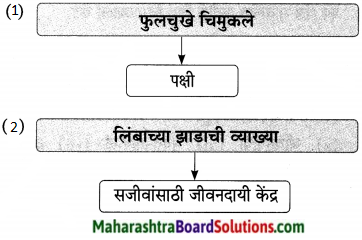
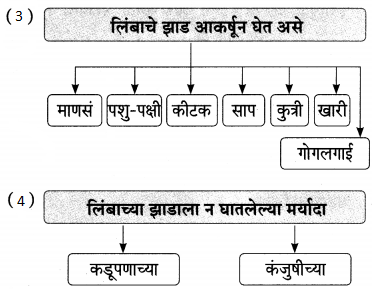
प्रश्न 3.
कोण ते लिहा.
- अद्भूत फळदार आश्वासन घेऊन आलेली.
- छोट्या फांदीवर पोळं रचणाऱ्या
- सजीवांसाठी जीवनदायी केंद्र.
- लिंबाचे झाड लावणारी.
उत्तर:
- फुले
- मधमाश्या
- लिंबाचे झाड
- दाक्षिणात्य स्त्री

प्रश्न 4.
आकृतिबंध पूर्ण करा.
उत्तर:
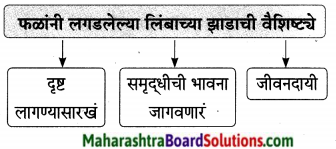
चूक की बरोबर ते लिहा.
प्रश्न 1.
- माणसंही त्या झाडाकडं आकर्षित होत होती.
- झाडाखाली मुंग्यांचंही एक वेगळंच विश्व होतं.
- तिनं त्या झाडाला कुंपण घातलं होतं.
उत्तर:
- बरोबर
- बरोबर
- चूक

कृती 3: व्याकरण कृती
प्रश्न 1.
खालील वाक्य लेखननियमांनुसार शुद्ध करून लिहा.
पण थंड सावलित कुत्रिही तिथं विसाव्याला येत.
उत्तरः
पण थंड सावलीत कुत्रीही तिथं विसाव्याला येत.
प्रश्न 2.
उताऱ्यातील दोन विशेषणे शोधून लिहा.
उत्तरः
- वेगळंच
- थंड
- सगळं
- चिमुकली
- वासाची
- अद्भूत
- फळदार
- छोट्या
- मागं
- जीवनदायी
- मुक्त-मोकळं
- आसपासचे
- लगडलेलं
प्रश्न 3.
अचूक शब्द लिहा.
1. जिवनदायी, जीवनदयी, जीवनदायी, जीवनदायि
2. रंगित, रगीत, रगित, रंगीत
उत्तर:
1. जीवनदायी
2. रंगीत

प्रश्न 4.
समानार्थी शब्द लिहा.
- छाया - [ ]
- विश्रांती - [ ]
- सुमन - [ ]
- वसाहत - [ ]
उत्तर:
- सावली
- विसावा
- फूल
- वस्ती
अधोरेखित शब्दाचा समानार्थी शब्द लिहून वाक्य पुन्हा छाया लिहा.
प्रश्न 5.
झाडाखाली मुंग्यांचंही एक वेगळंच विश्व होतं.
उत्तरः
झाडाखाली मुंग्यांचंही एक वेगळंच जग होतं.
विरुद्धार्थी शब्द लिहा.
प्रश्न 6.
- रंगहीन ×
- तिखट ×
- वर ×
- मोठ्या ×
उत्तर:
- रंगीत
- गोड
- खाली
- छोट्या

प्रश्न 7.
उताऱ्यातील दोन अनेकवचनी शब्द शोधून लिहा.
उत्तर:
- किडे
- कुत्री
- फुलं
- पऱ्या
- फुलपाखरं
- कीटक
- भुंगे
- फळं
- माणसं
- पशू
- पक्षी
- खारी
- गोगलगाई
प्रश्न 8.
तक्ता पूर्ण करा.
उत्तर:
| शब्द |
प्रत्यय |
विभक्ती |
| सावलीत |
त |
सप्तमी (एकवचन) |
| झाडाचा |
चा |
षष्ठी (एकवचन) |
| माश्यांनी |
नी |
तृतीया (अनेकवचन) |
| कंजुषीच्या |
च्या |
षष्ठी (एकवचन) |
प्रश्न 9.
तक्ता पूर्ण करा.
उत्तर:
| शब्द |
मूळ शब्द |
सामान्यरूप |
| माश्यांनी |
मासा |
माश्यां |
| वासाची |
वास |
वासा |
| सापाची |
साप |
सापा |
| विसाव्याला |
विसावा |
विसाव्या |
प्रश्न 10.
खालील वाक्यात अधोरेखित शब्दांऐवजी पाठात आलेला योग्य वाक्प्रचार शोधून वाक्य पुन्हा लिहा.
माणसंही त्या झाडाकडं ओढली जात होती.
उत्तरः
माणसंही त्या झाडाकडं आकर्षित होत होती.

प्रश्न 11.
वाक्यातील काळ ओळखा.
माणसंही त्या झाडाकडं आकर्षित होत होती.
उत्तर:
भूतकाळ
प्रश्न 12.
काळ बदला. (भविष्यकाळ करा)
आसपासचे लोक येत, लिंबाची फळं मुक्तपणे घेऊन जात.
उत्तरः
आसपासचे लोक येतील, लिंबाची फळं मुक्तपणे घेऊन जातील.
प्रश्न 13.
सहसंबंध लिहा.
स्त्री : नाम :: त्या : ……………………
उत्तरः
सर्वनाम
प्रश्न 14.
पर्यायी शब्द लिहा.
उत्तरः

कृती 4 : स्वमत
प्रश्न 1.
झाड सजीवांसाठी जीवनदायी केंद्र कसे बनू शकते हे विधान पटवून दया.
उत्तरः
झाडे सजीवांना चैतन्य देतात. सजीवांची मते प्रफुल्लित करतात. झाडे सजीवांच्या जीवनात आल्हाददायक गोडवा निर्माण करण्याचे कार्य करतात. या झाडांवर पर्यावरणातील अनेक कीटक, पक्षी, माणसं व इतर प्राणी आश्रय घेतात. असंख्य पशु-पक्षी, साप, खारी अनेक प्रकारचे कीटक व गोगलगाईंसाठी झाडे वरदान ठरतात. या सर्वांच्या विसाव्याचे केंद्र झाडेच असतात. झाडांभोवती रंगीबेरंगी फुलपाखरे उडताना दिसतात. जणू झाडांना पाहूनच ती नर्तन करत आहेत. असे वाटते. या सर्व प्रकारच्या सजीवांसाठी झाडे आपले सर्वस्व बहाल करत असतात..

पुढील उताऱ्याच्या आधारे दिलेल्या सूचनेनुसार कृती करा:
कृती 1 : आकलन कृती
प्रश्न 1.
आकृतिबंध पूर्ण करा.
उत्तरः
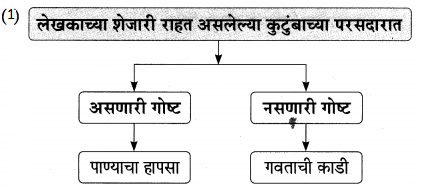
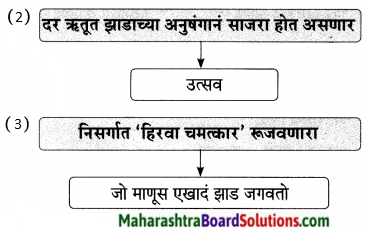
प्रश्न 2.
उत्तरे लिहा.
1. लखकाच्या शेजारी राहत असलेल्या लोकांनी कधी कसला प्रयत्न केला नाही?
2. लेखक का चकित होऊन गेला?
3. झाड लावलेली बाई आपल्यामागे काय ठेवून गेली?
उत्तर:
1. हिरवा आनंद पसरवण्याचा
2. झाडाला आलेलं महत्त्व पाहून
3. अद्भूत नाट्य

प्रश्न 3.
जोड्या जुळवा.
| ’अ’ गट |
‘ब’ गट |
| 1. हिरवा |
(अ) माणसं |
| 2. दुर्मुखलेली |
(ब) आश्वासनाचे |
| 3. संगीतमय संदेश |
(क) सजीवांचे |
| 4. आशीर्वाद घेणं |
(ड) चमत्कार |
उत्तर:
| ’अ’ गट |
‘ब’ गट |
| 1. हिरवा |
(ड) चमत्कार |
| 2. दुर्मुखलेली |
(अ) माणसं |
| 3. संगीतमय संदेश |
(ब) आश्वासनाचे |
| 4. आशीर्वाद घेणं |
(क) सजीवांचे |
खालील प्रश्नांची उत्तरे एका वाक्यात लिहा.
प्रश्न 1.
लेखकाच्या शेजारी राहत असलेल्या कुटुंबाच्या परसदारात काय होते?
उत्तर:
लेखकाच्या शेजारी राहत असलेल्या कुटुंबाच्या परसदारात पाण्याचा हापसा होता.
प्रश्न 2.
झाड जगवणारा माणूस निसर्गात काय रुजवत असतो?
उत्तर:
झाड जगवणारा माणूस निसर्गात ’हिरवा चमत्कार’ रुजवत असतो.
प्रश्न 3.
झाड लावलेली बाई आपल्यामागे काय ठेवून गेली होती?
उत्तरः
झाड लावलेली बाई आपल्यामागे अद्भूत नाट्य ठेवून गेली होती.
कंसातील योग्य शब्द वापरून रिकाम्या जागा भरा.
प्रश्न 1.
1. सर्व सजीवांचे ………….. घेणं ही एक प्रवृत्तीच असावी लागते. (आशीर्वाद, शाप, तळतळाट, अन्न)
2. परंतु न त्यांनी ते ‘हिरवं ………….. पाहिलं, न झाडं लावली. (आश्वासन, मन, कौतुक, धन)
3. मात्र अंगणात आणि ………….. गवताची काडीही नव्हती. (घरात, दारात, परसदारात, परसबागेत)
उत्तर:
1. आशीर्वाद
2. कौतुक
3. परसदारात

सहसंबंध लिहा.
प्रश्न 1.
सहसंबंध लिहा.
भरपूर : पाणी :: मुबलक :
उत्तर:
जमीन
शब्दसमूहांसाठी एक शब्द चौकटीत लिहा.
प्रश्न 1.
1. घरामागे असणारी जागा [ ]
2. साक्ष देणारा [ ]
उत्तर:
1. परसदार
2. साक्षीदार
कृती 2: आकलन कृती
प्रश्न 1.
योग्य पर्याय निवडून विधान पूर्ण करा.
कदाचित ती माणसं त्यांच्या परस-अंगणासारखीच उदास, भकास, तपकिरी अशीच वाटत राहिली मनानं; कारण …..………
(अ) हा निसर्गातला आनंद त्यांच्या मनात पोचल्याचं मी पाहिलंच नाही.
(ब) हा निसर्गातला आनंद त्यांच्या मनात पोचल्याचं मी पाहिलं.
(क) हा निसर्गाचा चमत्कारच त्यांनी पाहिला नाही.
(ड) त्यांचे परसदारच भकास आहे.
उत्तरः
कदाचित ती माणसं त्यांच्या परस-अंगणासारखीच उदास, भकास, तपकिरी अशीच वाटत राहिली मनानं; कारण हा निसर्गातला आनंद त्यांच्या मनात पोचल्याचं मी पाहिलंच नाही.

प्रश्न 2.
आकृतिबंध पूर्ण करा.
उत्तरः
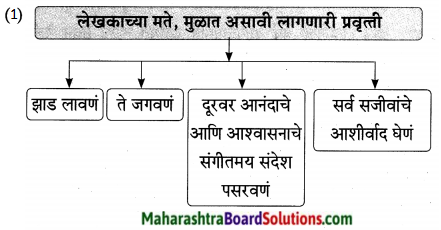
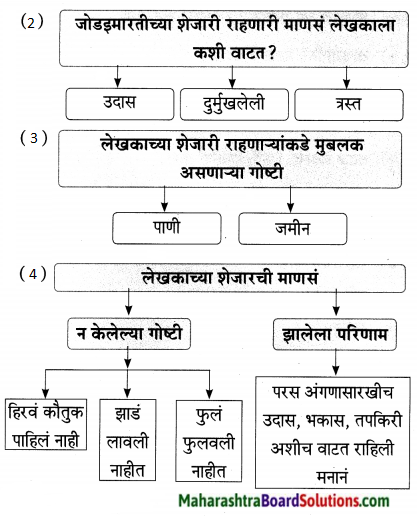
प्रश्न 3.
कोण ते लिहा.
सजीवांच्या जागत्या नांदत्या अस्तित्वाचा साक्षीदार.
उत्तरः
लेखक स्वतः
प्रश्न 4.
आकृतिबंध पूर्ण करा.
उत्तरः

सत्य की असत्य ते लिहा.
प्रश्न 1.
1. सर्व सजीवांचे आशीर्वाद घेणं ही एक विकृतीच असावी लागते.
2. ’पिवळ्या भाषेत’ मला असं बरंच काही सांगितलं.
उत्तर:
1. असत्य
2. असत्य

कृती 3 : व्याकरण कृती
प्रश्न 1.
खालील वाक्य लेखननियमांनुसार शुद्ध करून लिहा.
ज्या घराची हकिकत मी सांगतो आहे ती एक जोडीइमारत होती.
उत्तरः
ज्या घराची हकीकत मी सांगतो आहे, ती एक जोडइमारत होती.
प्रश्न 2.
उताऱ्यातील विशेषणे शोधून लिहा.
उत्तर:
- ट्विन
- पाण्याचा
- भरपूर
- उदास
- दुर्मुखलेली
- त्रस्त
- मुबलक
- हिरवा
- संगीतमय
- अद्भूत
- दर
- आख्खा
- अनेक
- भकास
- तपकिरी.
प्रश्न 3.
अचूक शब्द लिहा.
1. चमकार, चमकर, चमत्कर, चमत्कार
2. पवृती, परवृत्ती, प्रवृत्ति, प्रवृत्ती
उत्तर:
1. चमत्कार
2. प्रवृत्ती
समानार्थी शब्द लिहा.
प्रश्न 1.
- हैराण - [ ]
- भूमी – [ ]
- पुरेसे - [ ]
- वस्तुस्थिती - [ ]
उत्तर:
- त्रस्त
- जमीन
- मुबलक
- हकीकत

अधोरेखित शब्दाचे वचन बदलून वाक्य पुन्हा लिहा.
प्रश्न 1.
इतकं महत्त्व त्या झाडाला आलेलं पाहून मी चकित होऊन गेलो होतो.
उत्तरः
इतकं महत्त्व त्या झाडांना आलेलं पाहून मी चकित होऊन गेलो होतो.
विरुद्धार्थी शब्द लिहा.
प्रश्न 1.
- निर्जीव ×
- शाप ×
- दुःख ×
- क्वचित ×
उत्तर:
- सजीव
- आशीर्वाद
- आनंद
- नेहमी
प्रश्न 7.
उताऱ्यातील दोन अनेकवचनी शब्द शोधून लिहा.
उत्तर:
- माणसं
- दागिने
- अनेक
- झाडं
- फुलं

प्रश्न 8.
अधोरेखित शब्दांच्या जाती ओळखा
1. ती एक जोडइमारत होती.
2. जो माणूस एखादं झाड जगवतो.
उत्तर:
1. विशेषण
2. क्रियापद
प्रश्न 9.
अधोरेखित शब्दाचा विरुद्धार्थी शब्द लिहून वाक्य पुन्हा लिहा.
त्या घरातली स्त्री नेहमी दागिने घालून बसे.
उत्तरः
त्या घरातली स्त्री क्वचित दागिने घालून बसे.
प्रश्न 10.
तक्ता पूर्ण करा.
उत्तरः
| शब्द |
प्रत्यय |
विभक्ती |
| परसदारात |
त |
सप्तमी (एकवचन) |
| घाईने |
ने |
तृतीया (एकवचन) |
| शेजारची |
ची |
षष्ठी (एकवचन) |
प्रश्न 11.
तक्ता पूर्ण करा.
उत्तरः
| शब्द |
मूळ शब्द |
सामान्यरूप |
| गवताची |
गवत |
गवता |
| आनंदाचे |
आनंद |
आनंदा |
| अंगणात |
अंगण |
अंगणा |
| पाण्याचा |
पाणी |
पाण्या |

प्रश्न 12.
वाक्यातील काळ ओळखा.
इतकं महत्त्व त्या झाडाला आलेलं पाहून मी चकित होऊन गेलो होतो.
उत्तरः
भूतकाळ
प्रश्न 13.
काळ बदला (भविष्यकाळ करा)
ती बाई इथून निघून गेली होती.
उत्तरः
ती बाई इथून निघून जाईल.
प्रश्न 14.
सहसंबंध लिहा.
स्त्री : नाम :: ती : ……………………
उत्तर:
सर्वनाम
प्रश्न 15.
पर्यायी शब्द लिहा.
उत्तर:

कृती 4: स्वमत
प्रश्न 1.
झाडं जगवणे म्हणजे एक हिरवा चमत्कार रुजवणे असे जे म्हटले जाते ते तुम्हांस योग्य वाटत आहे का? तुमचे मत मांडा.
उत्तरः
झाडं जगवणे म्हणजे एक हिरवा चमत्कार रुजवणे असे जे म्हटले जाते ते मला योग्य वाटत आहे. झाडे हिरवी असतात. लावलेल्या एका रोपट्याची परिणती हळूहळू झाडात होते, व त्याचे एका मोठ्या वृक्षात परिवर्तन होते. हिरवाच हिरवा रंग दिसू लागतो जणू कोणीतरी हिरव्या रंगाची चादर परिधान केली आहे की काय असा भास होतो. अशा हिरव्या झाडाखाली माणसे विश्राम करतात. झाडावर येत असलेल्या फुलांचा वास घेतात, फळे खातात. शुद्ध हवेचा लाभ घेतात. झाडे पावसाला निमंत्रण देतात. ते पर्यावरणाचे रक्षण करतात म्हणून झाडे जगवणे म्हणजे एक हिरवा चमत्कार रुजवणे असे जे म्हटले जाते ते योग्यच आहे.

पुढील उताऱ्याच्या आधारे दिलेल्या सूचनेनुसार कृती कराः:
कृती 1 : आकलन कृती
प्रश्न 1.
आकृतिबंध पूर्ण करा.
उत्तरः
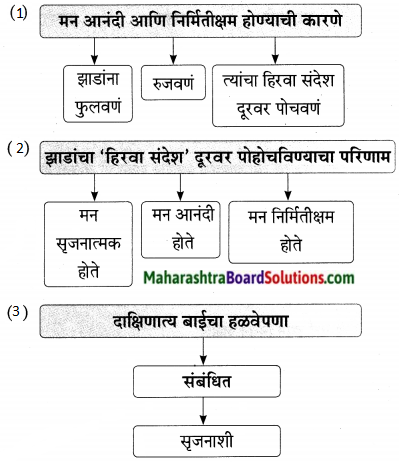
प्रश्न 2.
उत्तरे लिहा.
1. दाक्षिणात्य बाईचा हळवेपणा लेखकाला संबंधित वाटला.
2. नुसता भौतिक गोष्टींचा ध्यास घेतलेले वंचित राहतात.
उत्तर:
1. सृजनाशी
2. आनंदापासून

प्रश्न 3.
जोड्या जुळवा.
| ’अ’ गट |
‘ब’ गट |
| 1. सृजनाशी संबंधित |
(अ) मन |
| 2. भौतिक गोष्टीचा |
(ब) हिरवा संदेश |
| 3. निर्मितीशी जोडलेलं |
(क) ध्यास |
| 4. दूरवर पोचवणं |
(ड) दक्षिणात्य स्त्रीचा हळवेपणा |
उत्तर:
| ’अ’ गट |
‘ब’ गट |
| 1. सृजनाशी संबंधित |
(ड) दक्षिणात्य स्त्रीचा हळवेपणा |
| 2. भौतिक गोष्टीचा |
(क) ध्यास |
| 3. निर्मितीशी जोडलेलं |
(अ) मन |
| 4. दूरवर पोचवणं |
(ब) हिरवा संदेश |
खालील प्रश्नांची उत्तरे एका वाक्यात लिहा.
प्रश्न 1.
दाक्षिणात्य बाई कोणासह लेखकाच्या घरी आली होती?
उत्तरः
दाक्षिणात्य बाई तिच्या मुलासह लेखकाच्या घरी आली होती.
प्रश्न 2.
लेखकाच्या मते मन केव्हा ताजं राहतं?
उत्तरः
लेखकाच्या मते मन सृजनाशी नवनिर्माणाशी, निर्मितीशी जोडलेलं असेल तर ते ताजं राहतं.
कंसातील योग्य शब्द वापरून रिकाम्या जागा भरा.
प्रश्न 1.
1. एक मागं ठेवलेलं …………. झाड किती जीवांना जगवतं. (डेरेदार, सुगंधी, फळदार, बहरलेलं)
2. त्या जीवनदायी झाडानं आपल्या ‘………….. भाषेत’ मला असं बरंच काही सांगितलं. (पिवळ्या, काळ्या, गुलाबी, हिरव्या)
उत्तर:
1. फळदार
2. हिरव्या

सहसंबंध लिहा.
प्रश्न 1.
1. दाक्षिणात्य : बाई :: फळदार : ……………….
2. दुःख : आनंद :: शिळं : …………..
उत्तर:
1. झाड
2. ताजं
कृती 2: आकलन कृती.
प्रश्न 1.
योग्य पर्याय निवडून विधान पूर्ण करा.
दाक्षिणात्य बाईनं आल्याबरोबर ….………
(अ) प्रथम जाऊन ते घर पाहिलं.
(ब) प्रथम जाऊन ते झाड पाहिलं.
(क) प्रथम जाऊन झाड लावलं.
(ड) प्रथम जाऊन ते झाड तोडलं.
उत्तर:
दाक्षिणात्य बाईनं आल्याबरोबर प्रथम जाऊन ते झाड पाहिलं.
प्रश्न 2.
आकृतिबंध पूर्ण करा.
उत्तर:
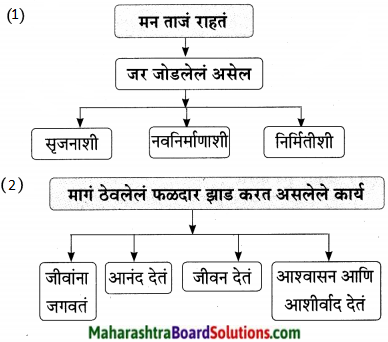
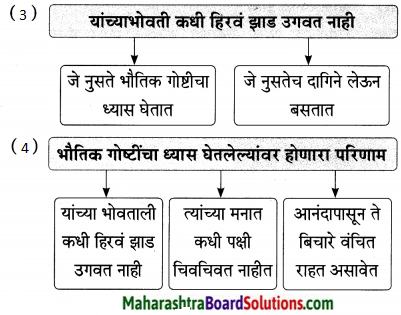
प्रश्न 3.
चूक की बरोबर ते लिहा,
1. तिचा तो हळवेपणा मला सृजनाशी संबंधित वाटला.
2. त्यांच्या मनात कधी पक्षी भिरभिरत नाही.
उत्तर:
1. बरोबर
2. चूक

कृती 3 : व्याकरण कृती
प्रश्न 1.
खालील वाक्य लेखननियमांनुसार शुद्ध करून लिहा.
आनदांपासून ते बीचारे वंचित राहत असावेत.
उत्तरः
आनंदापासून ते बिचारे वंचित राहत असावेत.
प्रश्न 2.
उताऱ्यातील सर्वनामे शोधून लिहा.
उत्तर:
- ते
- ती
- तिच्या
- तिनं
- तो
- मला
- त्यांचा
- त्यांच्या
- त्या
प्रश्न 3.
अचूक शब्द लिहा.
1. निमिर्तीक्षम, निर्मीतीक्षम, निर्मितीक्षम, नीमिर्तीक्षम
2. वचित, वचीत, वंचीत, वंचित
उत्तर:
1. निर्मितीक्षम
2. वंचित

प्रश्न 4.
समानार्थी शब्द लिहा.
- आयुष्य - [ ]
- उत्कट इच्छा - [ ]
- हमी - [ ]
- निरोप - [ ]
उत्तर:
- जीवन
- ध्यास
- आश्वासन
- संदेश
प्रश्न 5.
विरुद्धार्थी शब्द लिहा.
- शिळे × [ ]
- जवळ × [ ]
- दुःखी × [ ]
- मृत्यु × [ ]
उत्तर:
- ताजे
- दूर
- आनंदी
- जीवन
प्रश्न 6.
उताऱ्यातील दोन अनेकवचनी शब्द लिहा.
उत्तर:
1. दागिने
2. पक्षी
3. बिचारे
प्रश्न 7.
अधोरेखित शब्दाचा समानार्थी शब्द लिहून वाक्य पुन्हा लिहा.
ते झाडं लावणारी ती दाक्षिणात्य बाई एकदा तिच्या मुलासह आमच्या घरी आली होती.
उत्तरः
ते झाड लावणारी ती दाक्षिणात्य स्त्री एकदा तिच्या मुलासह आमच्या घरी आली होती.
प्रश्न 8.
तक्ता पूर्ण करा.
उत्तरः
| शब्द |
प्रत्यय |
विभक्ती |
| सृजनाशी |
शी |
तृतीया (एकवचन) |
| गोष्टीचा |
चा |
षष्ठी (एकवचन) |
| जीवांना |
ना |
द्वितीया (अनेकवचन) |
| भाषेत |
त |
सप्तमी (एकवचन) |

प्रश्न 9.
तक्ता पूर्ण करा.
उत्तरः
| शब्द |
मूळ शब्द |
सामान्यरूप |
| जीवांना |
जीव |
जीवां |
| झाडानं |
झाड |
झाडा |
| गोष्टीचा |
गोष्ट |
गोष्टी |
| निर्मितीशी |
निर्मिती. |
निर्मिती |
प्रश्न 10.
‘ध्यास घेणे’ वाक्प्रचाराचा अर्थ लिहून वाक्यात उपयोग करा.
उत्तर:
ध्यास घेणे - उत्कट इच्छा असणे
वाक्य : संत मदर तेरेसा यांनी गरीबांच्या सेवेचा ध्यास घेतला होता.
प्रश्न 11.
खालील वाक्यात अधोरेखित शब्दांऐवजी पाठात आलेला योग्य वाक्प्रचार शोधून वाक्य पुन्हा लिहा.
हे रहस्य ज्यांनी जाणलं ते मला वाटतं, आनंदी राहतात.
उत्तरः
हे मर्म ज्यांनी जाणलं, ते मला वाटतं, आनंदी राहतात.
प्रश्न 12.
वाक्यातील काळ ओळखा.
ती दाक्षिणात्य बाई एकदा तिच्या मुलासह आमच्या घरी आली होती.
उत्तरः
भूतकाळ
प्रश्न 13.
काळ बदला. (भविष्यकाळ करा)
तिचा तो हळवेपणा मला सृजनाशी संबंधित वाटला.
उत्तरः
तिचा तो हळवेपणा, मला सृजनाशी संबंधित वाटेल.

प्रश्न 14.
पर्यायी शब्द लिहा.
उत्तरः

कृती 4 : स्वमत
प्रश्न 1.
झाडे मानवी मनाला सृजनशील करत असतात यावर तुमचे मत सोदाहरण स्पष्ट करा.
उत्तरः
झाडे स्वत:च सृजनशील असतात. निरनिराळ्या ऋतूंत ती सजत असतात. स्वतः सृजनशील असल्यामुळे ती इतरांना देखील सर्जनशील बनवितात. वर्डस्वर्थला काव्याची देणगी झाडांनीच दिलेली आहे, म्हणूनच तो निसर्गाला दुसरा देव मानतो. याच वृक्षाखाली बसून वाल्मिकी ऋषींनी रामायण लिहिले. बालकवींना देखील कविता लिहिण्याची शक्ती झाडांनीच दिली. जेव्हा सर्वसामान्य माणसे बहरलेल्या हिरव्या झाडांकडे पाहतात तेव्हा त्यांच्या मनाला केवढा आनंद मिळतो याचे वर्णन करणे अवघड होईल. झाडावर उगवलेले प्रत्येक पाननपान मनुष्यास प्रेरणा देत असते. ते माणसाचे नाते नवनिर्माणाशी जोडत असते. झाडावरून खाली पडलेल्या फळाचे न्यूटनने निरीक्षण केले. या झाडांनीच त्याला विज्ञानाचा किती तरी मोठा शोध लावण्याची प्रेरणा दिली.
ते जीवनदायी झाड Summary in Marathi
लेखकाचा परिचय:
- नाव: भारत सासणे
- जन्म: 1951
- परिचय: प्रसिद्ध लेखक, कथाकार, नाटककार. कादंबरीकर ’अनर्थ’, ’लाल फुलांचे झाड’ हे कथासंग्रह: ‘सर्प’, ’दूर तेथे दूर तेव्हा’, ’रात्र’ या लघुकादंबऱ्या प्रसिद्ध.
प्रस्तावना:
‘ते जीवनदायी झाड’ हा पाठ लेखक ’भारत सासणे’ यांनी लिहिला आहे. फलदायी व जीवनदायी लिंबाचे झाड मानवी जीवन यांची सुंदर सांगड घालण्याचा यशस्वी प्रयत्न प्रस्तुत पाठात लेखकांनी केला आहे.
The write-up ’Te Jeevandayi Jhad’ is written by writer Bharat Sasane. The author has beautifully expressed his views perception of the endearing connection between benevolent lemon tree in his backyard and human life.

शब्दार्थ:
- जीवनदायी - जीवन देणारा (giver of life)
- गच्च - दाट (dense, thick)
- आसमंत - आसपासचा प्रदेश (surroundings)
- तपकिरी - (brown)
- मलूल - निस्तेज (faded)
- पाणथळ - ओल धरणारी जमीन (wetlands)
- शुष्क - कोरडे (dry)
- विलक्षण - विचित्र (strange)
- दिलासा - आश्वासन, उत्तेजन (encouragement, solace)
- केंद्र - मध्य (centre)
- बरबटणे - (चिखल, माती, धूळ इत्यादींनी) माखलेले असणे (to be smeared with dirt etc)
- निरखणे - बारकाईने पाहणे (to observe carefully)
- गुंजा - लाल आणि काळे ठिपके असलेल्या बिया
- जोडपं - नरमादी यांची जोडी (couple)
- गजबजलेले - खूप गर्दीने व्यापलेले (over-crowded)
- कलकलाट - गोंगाट, कोलाहल (a confused noise, chaos)
- गजबजाट - गलबला, गर्दी (loud noise)
- तप्त - गरम (hot)
- विश्व - सृष्टी, जग (universe)
- दलदल - चिखलाने भरलेली जमीन (marshy place)
- खार - (a squirrel)
- विसावा - आराम, विश्रांती (rest)
- कुंपण - संरक्षक भिंत (fence)
- परसदार - घराचा मागील भागात असलेले आवार (backyard)
- हापसा - पाण्याचा पंप (hand pump)
- दुर्मुखलेली - घुमी, आंबट चेहऱ्याची (sad gloomy morose)
- प्रवृत्ती - कल, ओढ (tendency, disposition)
- घमघमाट - आजूबाजूला सर्वत्र दरवळणारा सुगंध (rich fragrance spread all over)
- भकास - उजाड, उदास, ओसाड (desolate)
- थक्क - चकित, स्तंभित (surprised)
- मर्म - सुप्त गुणधर्म (the latent quality)
- वंचित - एखादी गोष्ट न मिळालेला (who is deprived of something)
- हकीकत - बातमी, वृत्तांत (statement, report)
- मुबलक - विपुल, पुष्कळ (abundant)
- चमत्कार - आश्चर्य (a wonder)
- अद्भुत - आश्चर्य, नवल (a wonder)
- साक्षीदार : - पुरावा देणारा (a witness)
- भौतिक - जगातील स्थावर वस्तूंसंबंधी (material)
- सृजन - नवनिर्मिती (creation)
टिपा:
1. कडूलिंब - हा भारतीय उपखंडातील पाकिस्तान, भारत, नेपाळ व बांग्लादेश या देशात आढळणारा वृक्ष आहे. या वृक्षात त्याच्या परिसरातील हवा शुद्ध आणि आरोग्यपूर्ण राखण्याचे सामर्थ्य आहे. या झाडाचाप्रत्येक भाग कोणत्या ना कोणत्यातरी आजारावर गुणकारी आहे.
2. गोगलगाय - हा मृदुकाय प्राणी आहे. गोगलगाईंच्या शरीरावर कवच असते यालाच शंख असेही म्हणतात.
3. पारवा - पक्ष्यांची एक प्रजाती. हे साधारणत: 32, सें. मी. आकारमानाचे निळ्या राखाडी रंगाचे पक्षी असतात.
4. तुरेदार बुलबुल - हा पक्षी आकाराने साधारणात: 7 इंच असतो. ह्या पक्ष्याचा वरचा रंग गडद तपकिरी असतो तर पोटाकडे ते शुभ्र पांढरे असतात. डोक्यावर लांब, ऐटदार काळ्या रंगाचा तुरा असतो. यास ’रेड विस्कर्ड बुलबुल’ असेही म्हणतात.

वाक्प्रचार:
- आश्वासन देणे - हमी देणे
- दृष्टीस पडणे - नजरेस पडणे
- आकर्षित होणे - ओढले जाणे
- ध्यास घेणे - एाखादया गोष्टीचा स्तत विचार करणे
- मर्म जाणणे – रहस्य जाणणे
9th Std Marathi Questions And Answers:
![]()

![]()
![]()

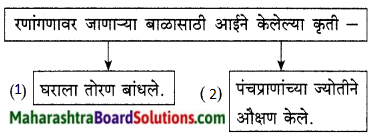
![]()


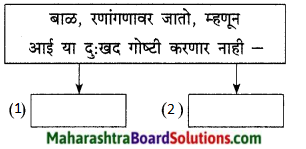
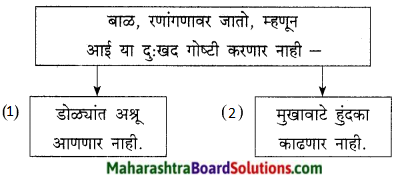
![]()
![]()
![]()
![]()
![]()
![]()
![]()



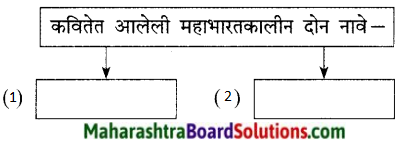
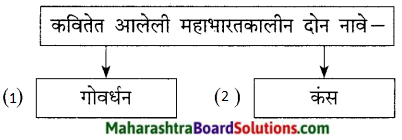
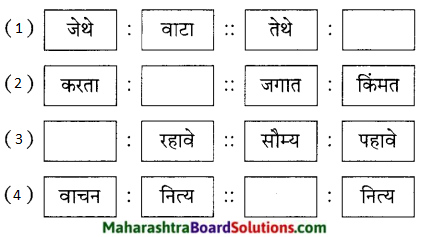
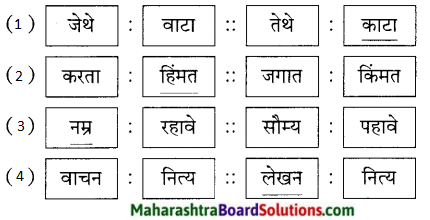
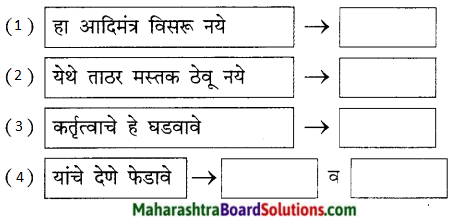



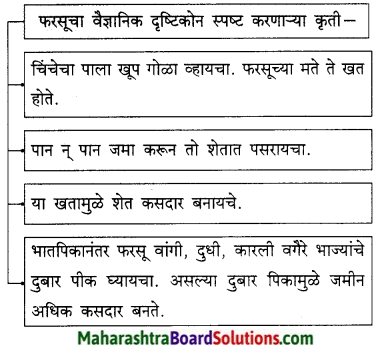

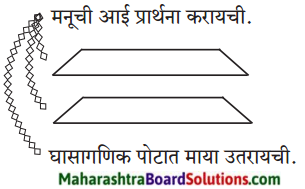

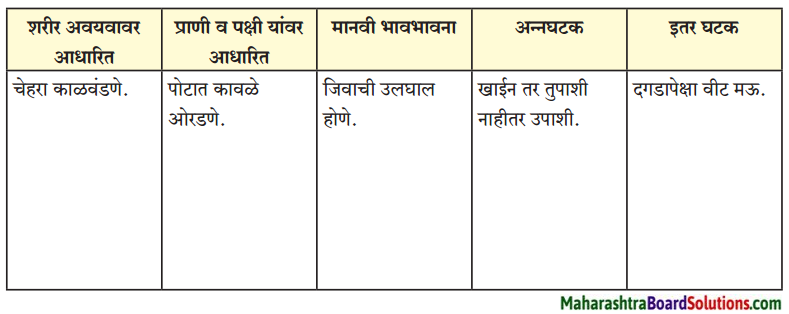 उत्तर:
उत्तर: